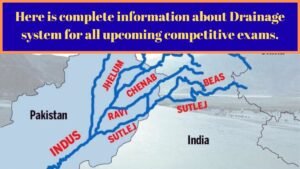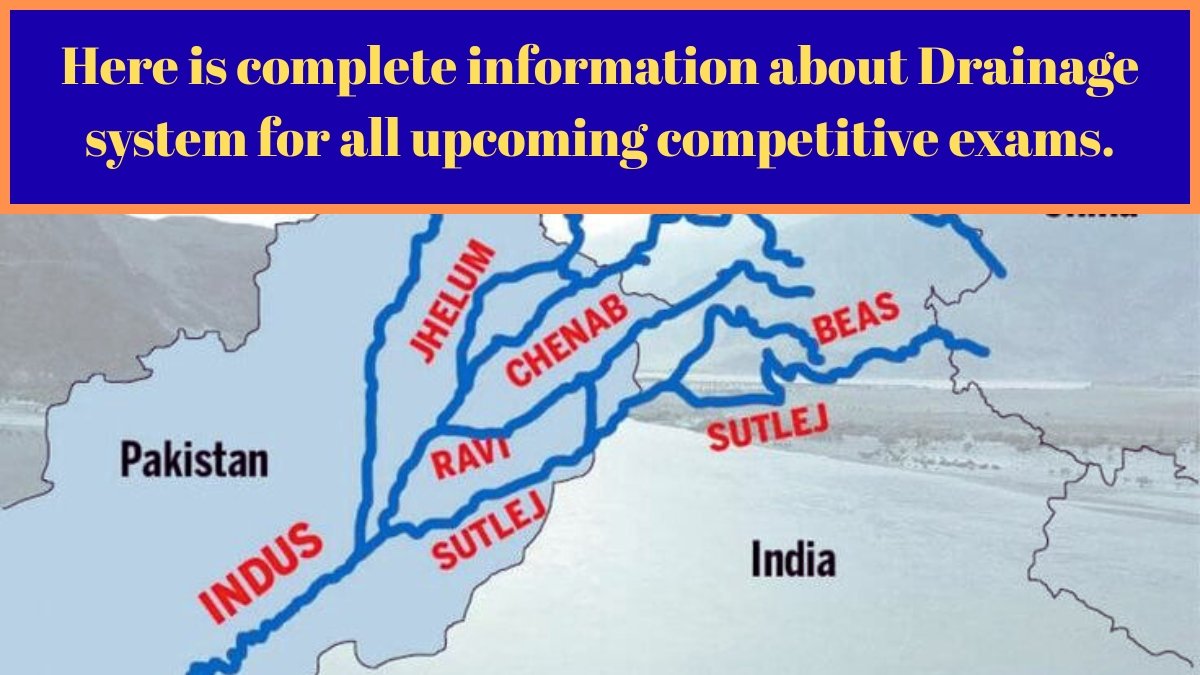Drainage system:Here is complete information about Drainage system for all upcoming competitive exams.

1.The largest irrigation canal in India is called the.
1) Yamuna canal
2) Sirhand canal
3) Indira Gandhi canal
4) Upper Bari Doab canal
Ans:-3) Indira Gandhi canal.
3) The Indira Gandhi Canal is the largest canal project in India.
• It begins at the Harike Barrage in Sultanpur, a few kilometers downstream from the confluence of the Sutlej and Beas rivers in the state of Punjab.
• It provides irrigation facilities to the northwestern region of Rajasthan, a part of the Thar Desert.
• It consists of the Rajasthan Feeder Canal (first 167 km in Punjab and Haryana and remaining 37 km in Rajasthan) and 445 km of the Rajasthan Main Canal, which is entirely in Rajasthan.
• Indira Gandhi Canal construction started in 1952, first used in 2005
• Water is channeled through it for agriculture in the Thar Desert region.
—————————————————
2.Which from the following rivers does not originate in Indian territory?
1) Mahanadi
2) Brahmaputra
3) Ravi
4) Chenab
Ans:-2) Brahmaputra
2) Brahmaputra River This is one of the largest river systems in the world.
• It originates in the snow-capped region of ‘Chemyangdung’ near Lake Manasarovar (China). The Tamhak Khambab spring is considered the source of the Brahmaputra River.
• In Tibet, the Brahmaputra River is called ‘Tsang-po’. Tsang-po means Purifier, and on Chinese maps it is called Yarlung – Zangbo Jiang.
• In India it is called ‘Brahmaputra’, while in Bangladesh it is called ‘Jamuna’. Although this river is 2,580 km long, it flows for 750 km in India.
• It enters India through Noida Barwa (Arunachal Pradesh) and flows through the high Himalayan ranges.
—————————————————-
3.The Siachin Glacier’s melting waters are the main source of which of the following rivers.
1) Beas
2) Sutlej
3) Shyok
4) Nubra
Ans:-4) Nubra
4) The Nubra River is a tributary of the Shyok River, which originates from the Remo Glacier, one of the Siachen Glaciers.
• It flows through the Nubra Valley in northern Ladakh and then joins the Indus River at Skardu in Pakistan.
—————————————————-
4.Which of the following are alternative names for the river “Brahmaputra”?
1) Yamuna, Yarlung Zangbo and Tsangpo
2) Yamuna, Megna and Tsangpo Yamuna
3) Jamuna, Siang, Yarlung Zangbo and Tsangpo
4) Jamuna, Siang, Yarlung Zangbo, Megna and Tsangpo
Ans:-4) Jamuna, Siang, Yarlung Zangbo, Megna and Tsangpo..
(4) The Brahmaputra River is called Yarlung -Zangbo Jiang in Chinese maps. In Tibet, the Brahmaputra River is called ‘Sango’. In India, it is called ‘Brahmaputra’, and in Bangladesh, it is called ‘Jamuna’.
• The Twango River enters India at Bishing. From there it is called the “Siang River”. It enters India through Arunachal Pradesh as the Siang or Dihang River and then flows further to join the Lohit and Dibang rivers before being called the Brahmaputra.
• After joining the Padma River (Ganga River in India) in Bangladesh, it flows into the Jamuna River and empties into the Bay of Bengal.
Major tributaries of the Brahmaputra River
• Left bank:- Siang River, Dibang, Lohit, Burhidiheng, Dhansiri, Kopili
• Right bank:- Subansiri, Kameng, Manas, Sankosh, Raidak, Jalalka, Teesta
—————————————————-
5.The confluence of the rivers Alaknanda and Bhagirathi is known as.
1) Rudraprayag
2) Devaprayag
3) Haridwar
4) Kedarnath
Ans:-3) Haridwar
• The Ganges River has two tributaries, ‘Bhagirathi’ and ‘Alaknanda’.The Bhagirathi River originates in Gangotri.
• The Alaknanda River originates near Badrinath in the Garhwal Himalayas.
• Both of these come together at ‘Devaprayag’ and continue to flow to become the Ganges River.
Prayag/Converging rivers
1) Vishnu Prayag -Alaknanda & Dauli Ganga
2) Nand Prayag – Alaknanda & Nandakini
3) Karna Prayag – Alaknanda & Pindar Ganga
4) Rudraprayag – Alaknanda & Mandakini
5) Deva Prayag – Alaknanda & Bhagirathi
• At Prayagraj – the Yamuna River joins the Ganges.
• The Farakka Dam has been built across the Ganges River in West Bengal. Through it, the Ganges River flows into the Hooghly River and the Padma River.
————————————————————————–
6. If Hwang Ho is the sorrow of China which river is sorrow of Bihar?
1) Damodar river
2) Koshi River
3) Yamuna river
4) Ravi river
Ans:-Koshi River
(2) The peak ‘Pandmashikhara’ is in the far north and is called the source of the Kosi.
• In Nepal, the Kosi is called the ‘Arun River’.
• The Kosi River, known as the ‘Tears of Bihar’, has been displaced by more than 100 km, posing a constant threat of devastating floods in Bihar.
• Tributaries of the Ganges River:- Left bank: Ram Ganga, Gomti, Gandak, Kosi, Mahananda, Kali Sharada, Ghaghra, Right bank: Yamuna, Son, Tones, Karmanasa, Punpun, Kiul
• Kosi River:- The Kosi River is called ‘Saptakosi’ because it consists of 7 rivers. In 1965, Nepal & India jointly built a dam across it to control floods.
7. In North-East India is known to be the largest freshwater lake.
1) Dal Lake
2) Chilika Lake
3) Loktak Lake
4) Tsomoriri Lake
Ans:- 2) Chilika Lake
(3) Lokshak Lake is the largest freshwater lake in North-East India.
• It is located near Moirang in Manipur. It is famous for the floating phamis (a mass of vegetation, soil and organic matter at various stages of decomposition) that float on it. It falls under the Ramhar belt.
• As of November 1, 2022, there are 75 Chaugu sites in India (Ranganathittu in Karnataka)
————————————————————————–
8.What is Damodar Valley Corporation?
1) Statutory body
2) Municipal Corporation looking after Damodar Valley
3) A private enterprise located in Bihar
4) A non government organisation
Ans:-3) A private enterprise located in Bihar
(1) Damodar Valley Corporation (DVC), has its headquarters in Kolkata.
• It is a statutory body created under the Damodar Valley Corporation Act 1948.
• It operates several power stations in the Damodar River region of West Bengal & Jharkhand.
• This corporation operates thermal power stations & hydroelectric power stations under the Union Ministry of Power.
————————————————————————–
9.On the tributary of which river has Rihand Dam been constructed ?
1) Chambal
2) Yamuna
3) Sone
4) Periyar
Ans:-2) Yamuna
• Rihand Dam is a concrete gravity dam located in Pimpri, Sonbhadra district, Uttar Pradesh, India.
• Rihand rises from the Matiranga Hills in the southwestern region of the Mainpat Plateau, at an altitude of about 2100 meters above sea level.
• This is one of the most important multipurpose river valley projects in Uttar Pradesh.
• Rihand is one of the main tributaries of the Son River, across which a 92 m. high and 934 m. long dam has been built near Pimpri in Mirzapur district. Its reservoir is 466 sq. km. wide and is called ‘Govind Vallabh Pant’ Sagar.
• In addition, another dam has been built near Obra, 25 km away from this dam, which is called Rihand Dam.
————————————————————————–
10. River Indus originates from:
1) Hindukush range
2) Himalayan range
3) Karakoram range
4) Kailash range
Ans:-3) Karakoram range
• The Indus River is one of the most important river systems of India. It originates near Mount Kailash (6714 m. high) and is 2880 km. long.
• It flows only 709 km in India. It flows northwest through a narrow gorge between the Ladakh and Jaskar ranges in the state of Jammu and Kashmir.
————————————————————————-
11. Which one of the following rivers of India does not make a delta ?
1) Ganges
2) Godavari
3) Mahanadi
4) Tapti
Ans:-2) Godavari
• Tapti: The second largest west-flowing river in the Paryai region. It originates at Multai in Madhya Pradesh, flows through the rift valleys between the Satpura and Ajanta ranges, and joins the Arabian Sea near Surat in Gujarat.
• The Ukai Project (Vallabha Sagar Project) for the Tapi River, the Tawa River Valley Project, and the Kakrepur Dam have been built on this river.
• The Tapti River originates in the Satpura Range of Multai in Betul district of Madhya Pradesh. It flows westwards for a length of 724 km before emptying into the Arabian Sea through the Gulf of Khambhat. The river is named after Goddess Tapti, the daughter of the Sun God and Chhaya.
• Tapati is the sister of Shani, Bhadra, Yamuna and Yama.
————————————————————————
12. Surat is situated river on the banks of the
1) Tapti
2) Mahanadi
3) Bhima
4) Godavari
Ans:- 1) Tapti
(1) Surat, formerly known as Suryapur, is a well-developed commercial city in the Indian state of Gujarat. It is situated on the left bank of the Tapti River (Tapi). The city is mostly known for its textile and diamond trade. It is also known as the Diamond Capital of the World and the Textile Capital of India/Manchester of Textiles.
• It is known as the “Embroidery Capital of India” for having the largest number of embroidery machines.
————————————————————————
13. The sideways erosion which widens the river valley called?
1) Lateral Corrosion
2) Vertical Corrosion
3) Side Corrosion
4) Mean Corrosion
Ans:-1) Lateral Corrosion
(1) Lateral erosion: The river bed widens as the heavy material of the river collides with the sides of the river. This gradually widens the V-shaped valleys. This is predominant in the youth of the river.
• Corrosion: This is the chemical erosion of rocks by the river.
Many of the minerals contained in it are soluble in water. The process of these minerals dissolving in water is called dissolution.
———————————————————————-
14. Which of the following groups of rivers have their source of origin in Tibet?
1) Brahmaputra, Indus and Sutlej
2) Ganga, Sutlej and Yamuna
3) Brahmaputra, Ganga and Sutlej
4) Chenab, Ravi & Sutlej
Ans:-1) Brahmaputra, Indus and Sutlej
(1) The Brahmaputra, Indus and Sutlej have their sources in Tibet.
• The Brahmaputra River is one of the largest river systems in the world. It originates in the snow-capped region of ‘Chemyangdung’ near Lake Mansarovar (China).
• The Indus River originates in the western part of Tibet near Mount Kailash & Lake Manasarovar.
• The source of the Sutlej originates near Lake Rakas in Tibet.
——————————————————————–
15. The ‘Pong Dam’ is constructed on the river
1) Ravi
2) Tapti
3) Beas
4) Don
Ans:-3) Beas
(3) Pang Dam, also known as the Beas Dam, is a dam built on the Beas River above Talwar in the state of Himachal Pradesh.
• Bhakra Nangal Dam: Built on the Setluj River in Himachal Pradesh. Its backwater is called Govinda Sagar.
• Hirakud Dam: Built on the Mahanadi River in Sambalpur district of Odisha.
• Nagarjuna Dam: Built on the Krishna River in Andhra Pradesh.





